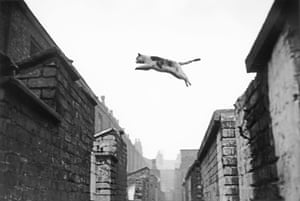via 3 Quarks Daily: Robin Kimmerer in Orion

© Simen Johan, Courtesy Yossi Milo Gallery, New York
A cemetery seemed an odd place to contemplate the boundaries of being. Sandwiched between the campus and the interstate, this old burial ground is our cherished slice of nearby nature where the long dead are silent companions to college students wandering the hilly paths beneath rewilding oaks. The engraved names on overgrown headstones are upholstered in moss and crows congregate in the bare branches of an old beech, which is also carved with names. Reading the messages of a graveyard you understand the deep human longing for the enduring respect that comes with personhood. Names, names, names: the stones seem to say, “I am. You are. He was.” Grammar, especially our use of pronouns, is the way we chart relationships in language and, as it happens, how we relate to each other and to the natural world.
Continue reading
=============================
via the Guardian by Nicola Davis

Scientist Marie Jackson has said Swansea lagoon’s seawall should be built using Roman concrete. Photograph: Tidal Lagoon Power/PA
Their structures are still standing more than 1,500 years after the last centurion snuffed it: now the Romans’ secret of durable marine concrete has finally been cracked.
The Roman recipe – a mix of volcanic ash, lime (calcium oxide), seawater and lumps of volcanic rock – held together piers, breakwaters and harbours. Moreover, in contrast to modern materials, the ancient water-based structures became stronger over time.
Continue reading
=============================
via Boing Boing by Andrea James

The inedible green leaves left behind during pineapple harvesting contain fibers that can be transformed into goods traditionally made from leather, including shoes, bags, and other leather accessories. Pinatex has details.
Continue reading
=============================
via 3 Quarks Daily by Muhammad Aurangzeb Ahmad
A cultural shift in our understanding of the arbitration of the truth is afoot. The shift is subtle but it has been creeping up in the collective unconscious for the last decade or so. Discourse on alternative facts and fake news has come to prominence since the last US presidential election and Brexit. This phenomenon is however not new but has a long and notorious lineage: Propaganda is as old as human civilization. The Nazi minister of Propaganda Joseph Goebbels is well known for developing a master plan for spreading false information and influencing the German populace. The Soviet Union and the Warsaw Pact nations had their own versions of “truths” where all of history was rewritten through the singular lens of Marxism. The supposed end of history with the Fall of Soviet Union did not end the need for propaganda. People and states still need to spread misinformation as before. There is however one thing that has changed about spreading mass misinformation: In prior times, spreading falsehood on a massive scale almost always required access to state resources. Then the internet happened followed by the rise of social media; this has made the spread of misinformation on a global scale a truly democratic endeavor.
Continue reading there are links to some really interesting reports of historical misinformation.
=============================
via Boing Boing by Mark Frauenfelder

This is a baron caterpillar. It is a cryptic bug, not a masquerading bug.
Continue reading
=============================
via Interesting Literature
A summary of a classic poem
There was a time when every schoolchild could quote lines from Thomas Gray’s poem ‘Elegy Written in a Country Churchyard’, since it was a popular poem to be taught, learnt by rote, and analysed in schools in Britain. Gray’s poem gave Thomas Hardy the phrase ‘far from the madding crowd’ for use as the title of his fourth published novel; the phrase ‘paths of glory’ was used as the title for Stanley Kubrick’s 1957 anti-war film; and the phrase ‘mute inglorious Milton’ has become well-known. But in recent decades its popularity has declined.
Is it still worth reading, studying, and subjecting to close analysis?
Yes, yes, and yes.
First, here’s a reminder of the text of ‘Elegy Written in a Country Churchyard’, before we move on to explain
1) why it isn’t an elegy,
2) why Gray didn’t want it published, and
3) how an obscure poet who died young helped to sow the seeds of this great
poem.
Continue reading
=============================
via ResearchBuzz Firehose: William Floyd for Google Blog
The park is not a big one. It’s a few thousand square-foot triangle in the Greenwich Village neighborhood of Manhattan, populated by a handful of trees and benches. Looking at it, you wouldn’t know that one night in June 1969, it hosted a crucial turning point in LGBTQ history. Across the street at the Stonewall Inn, a neighborhood gay bar, police broke down the door intending to haul the patrons off for a night in jail. Bar-goers resisted and a riot broke out in the park – it lasted several days and sparked what many recognize as the start of the modern day LGBTQ rights movement.
Continue reading
=============================
via OUP Blog by Heather Smith

The Palace of Westminster in London, the meeting place of the Parliament of the United Kingdom by Mike Gimelfarb. Public Domain via Wikimedia Commons.
The Labour Party of Great Britain was formed in 1900 and during the early decades of the century struggled as the opposition to Conservative Party, forming minority governments, under Ramsay McDonald, for only brief periods. Clement Attlee, representing London’s East End in Parliament, was there through those early struggles, a witness to Labour’s near annihilation in 1931, when it was reduced to just fifty-two seats in Parliament, and a central figure in its slow recovery over the following decade. He became the Labour leader in 1935, bringing the party into the wartime coalition in 1940, siding with Winston Churchill at Britain’s proverbial darkest hour. In 1945, the war over, Labour won an overwhelming mandate to carry out the most radical program ever presented to the British electorate by a major party. Attlee replaced Churchill as prime minister.
Continue reading
=============================
via Boing Boing by Mark Frauenfelder
This brass-and-steel “detector” doorlock, on display at Holland’s Rijksmuseum, was made in 1680 or so. It has lots of clever features. To open and close the latch, you have to fiddle with the man’s hat. The keyhole is hidden under the man’s leg. It has a dial counter that lets you know how many times it has been unlocked, so the owner can tell if someone else opened it. When the lock has been opened 100 times as indicated on the dial, the main bolt can be locked, but not released until a tiny button on the man’s chest is pressed, which resets the counter.
Continue reading and watch the short video
=============================
Flat caps and bowler hats: Neil Libbert’s bygone Britain – in pictures
via the Guardian
For six decades, the celebrated Guardian photojournalist has chronicled everyday British life. Here, he trains his lens on postwar austerity – and flying cats.

No comments:
Post a Comment